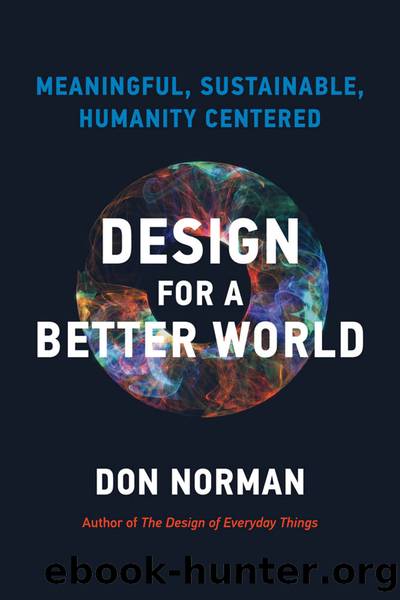Design for a Better World by Don Norman

Author:Don Norman [Norman, Don]
Language: eng
Format: epub
Tags: age of waste; artificial world; collaborative; planned obsolescence; Sustainability; circular economy; UI; user interface; UX; user experience; Design of Everyday Things; DOET; economics; education; measurement; technology; industrial design; hci; user centered design; GDP; behavior; systems;
Publisher: MIT Press
Published: 2023-02-17T00:00:00+00:00
23
Democratizing Design and Development
Step One: Community-Driven Design
The first step toward humanity-centered design lies in principle 5: design with the community and as much as possible support designs by the communityâpractices often simplified as âDesign with and by, not for.â
The approach of designing with the people rather than for them is well established in today's design field, even if not yet a major component of the foreign aid groups. I emailed a query to the 3,000 members of the PhD design discussion list (phd-design), asking when these forms of collaborative design started. I received a large number of thoughtful, delightful answers. The consensus was that it was difficult to know the exact starting date or who was at the very beginning, so the answer is simply âa very long time ago.â Over time, the design community developed many different ways in which to work with the people who are to receive the aid. Some of my correspondents placed an emphasis on designing with people instead of for them. Others emphasized the importance of having the design done by the people.
These approaches have been given numerous names: âcooperative design,â âcodesign,â âparticipatory design,â âcitizen-led, community-driven, or citizen design,â âdesign for social innovation,â âconvivial design,â âregenerative design,â and others. They differ in the details but are the same in spirit. And it isn't just the design community that does this work. Numerous disciplines do: social workers, public-health professionals, civic leaders, foundations, and nongovernment agencies. Elizabeth Sanders and Pieter Jan Stappers offer an excellent review and treatment of collaborative design in their book Convivial Toolbox: Generative Research for the Front End of Design, which is devoted to detailed illustrations of how to work with communities, including case histories.
There are many difficulties in working with communities. Community members themselves do not often agree upon the goals and potential solutions. There are often internal power struggles within the community, with different groups aiming for control over the activities. Quite often political and government officials become involved, not always for the benefit of the local communities. Those who work on community issues have to develop expert social and political skills to navigate the terrain. The danger is that the funding is apt to be dispersed in ways that distort the goal of the aid. All these difficulties reinforce my long-stated belief that important projects are always difficult. If they weren't difficult, the issues probably would have already been solved. Designers and other professionals who wish to help, support, and empower local communities have challenging but important jobs.
Download
This site does not store any files on its server. We only index and link to content provided by other sites. Please contact the content providers to delete copyright contents if any and email us, we'll remove relevant links or contents immediately.
| Decorative Arts | Design History & Criticism |
| Furniture Design | Industrial & Product Design |
| Interior & Home Design | Jewelry Design |
| Textile & Costume |
POP by Steven Heller(2884)
Japanese Design by Patricia J. Graham(2556)
The Power of Broke by Daymond John(2376)
Architecture 101 by Nicole Bridge(2350)
Fusion 360 for Makers by Lydia Sloan Cline(1987)
Indistractable: How to Control Your Attention and Choose Your Life by Nir Eyal(1936)
Origami Art by Michael G. Lafosse & Richard L. Alexander(1735)
Actionable Gamification: Beyond Points, Badges, and Leaderboards by Yu-kai Chou(1723)
Batik by Rudolf Smend(1720)
Homebody by Joanna Gaines(1711)
Worn in New York by Emily Spivack(1619)
Feng Shui by Stephen Skinner(1616)
Whiskey in a Teacup by Reese Witherspoon(1577)
Austin Kleon by Steal Like an Artist(1537)
Don't Make Me Think, Revisited: A Common Sense Approach to Web Usability by Steve Krug(1528)
Simple Gatherings by Melissa Michaels(1512)
Hygge: The Danish Art of Happiness by Marie Tourell Søderberg(1428)
The Joy of Hygge by Jonny Jackson(1341)
The Laws of Simplicity by John Maeda(1301)
